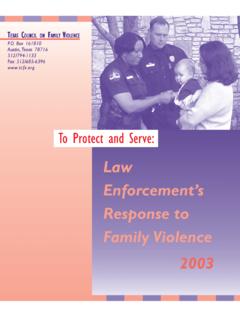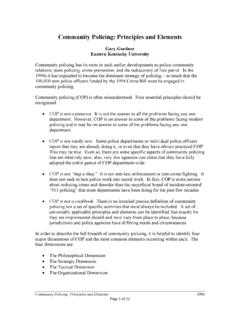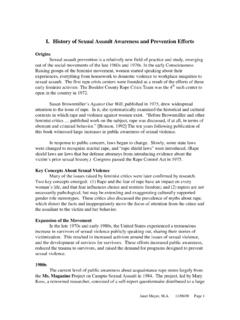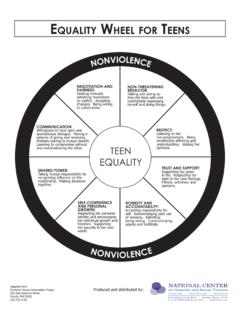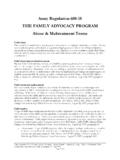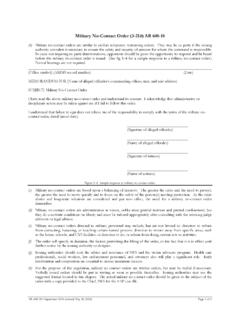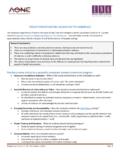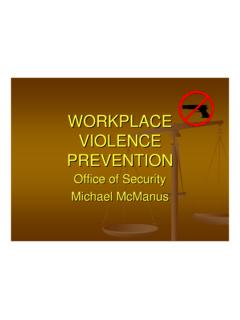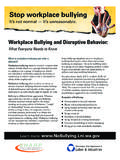Transcription of Workplace Violence and Corporate Policy for Health Care
1 Workplace Violence and Corporate Policy for Health Care Settings Page 1 of 10 Nursing Economics$ (No. 3, Vol. 23) May 1, 2005 Workplace Violence and Corporate Policy for Health Care Settings By Clements, Paul T.; DeRanieri, Joseph T.; Clark, Kathleen; Manno, Martin S.; Kuhn, Douglas Wolcik AUTHOR-ABSTRACT: * Nonfatal assaults occur nearly four times more often in Health care than in all private sector industries combined.; * Compounded by performance pressure, the Health care Workplace has become a pressure cooker for leaders and staff alike.; * Ideally, the Workplace is free of Violence , in terms of threats or actions, either verbal or physical.; * A comprehensive organizational Violence prevention program begins with a zero tolerance for Violence Policy and is supported by a data collection mechanism to monitor Violence , ongoing prevention initiatives, and a post-event support plan.
2 ; * Workplace Violence monitoring tools typically capture the type, mode, and severity of the incident and, like safety monitoring tools, support the identification of trends for ongoing intervention and education.; * In the event of a severely violent event, the organizational response should encompass a variety of group and individual efforts to support and stabilize the staff and work environment immediately, and in the many months to follow. TYPICALLY THOUGHT OF AS safe places, Health care agencies are now facing a significant increase in multidirectional acts of aggression from personnel, clients, and visitors (National Institute of Occupational Safety and Health [NIOSH], 2003). Media coverage of Workplace Violence has heightened the underlying sense of insecurity about when, where, and how the next traumatic event will occur.
3 Health care providers are now confronted with the idea that it could happen here and it could happen to me. In response , organizations are focusing on developing or enhancing Workplace safety Policy and adopting preventive measures, methods for early detection, psychological post-trauma interventions, and methods of maintaining Corporate function after sentinel events resulting from Workplace Violence (Bendersky-Sacks, Clements, & Fay-Hillier, 2001; NIOSH, 2003; Occupational Safety and Health Administration [OSHA], 2004). Most mainstream media cover sensational, dramatic, and rare types of violent assaults, such as those carried out by disgruntled employees. Concentrating only on the gunman type of assault can distract employees from focusing on other significant, but less dramatic risk factors that can be just as dangerous.
4 For example, one of the most common types of Workplace Violence occurs when the language or behavior of another employee, a patient, or a visitor is perceived as Workplace Violence and Corporate Policy for Health Care Settings Page 2 of 10 threatening. Other examples include ( Department of Health and Human Services [USDHHS], 2002): Threats. Expressions of intent to cause harm, including verbal threats, threatening body language, and written threats. Physical assaults. Attacks ranging from slapping and beating to rape, homicide, and the use of weapons such as firearms, bombs, or knives. Muggings. Aggravated assaults, usually conducted by surprise and with intent to rob. The overarching reality in the Health care Workplace is that many employers now find themselves dealing with Workplace Violence , including assault; property damage; racially, ethnically, or religiously motivated Violence ; sexual assault; employee suicide; or homicide.
5 Regardless of a Health care agency s size or mission, when unexpectedly confronted with Workplace Violence , staff members are typically overwhelmed with shock, followed by multiple questions surrounding how the event could have occurred in the safety of the Workplace (DeRanieri, Clements, & Henry, 2002). It is often impossible to separate the roles of the professional and the person in an attempt to cope with the occurrence of Workplace Violence (Clements et al., 2003). Therefore, when tragedy strikes a peaceful and productive workforce head-on, chaos and debilitation can ensue, necessitating immediate intervention and stabilization (Bendersky-Sacks, Clements, DeRanieri, KlinckKrentel, & Fay-Hillier, 2000; Bendersky-Sacks et al.)
6 , 2001). The current Health care environment often requires that employees maintain optimal performance even in the immediate chaotic aftermath of Workplace Violence . However, without time to examine how the traumatic event may be interpreted within their own personal, moral, ethical or cultural code, there may be a disruption in Corporate function and provision of care (Clements & Bradley, 2005, Clements, DeRanieri, Fay-Hillier, & Henry, 2003). Awareness of the dynamics and issues related to trauma, loss, and ongoing fear after Workplace Violence can guide Policy and related interventions to promote stability and provide a platform for adapting to the potential devastation of such a traumatic event (Bendersky-Sacks et al.
7 , 2001; DeRanieri et al., 2002). Incidence of Violence in the Workplace Today more than 5 million hospital workers from many occupations perform a wide variety of duties. They are exposed to many safety and Health hazards, including Violence . Recent data indicate that hospital workers are at high risk for experiencing Violence in the Workplace . According to estimates of the Bureau of Labor Statistics, 2,637 nonfatal assaults on hospital workers occurred in 1999 ( assaults per 10,000 workers). This rate is much higher than the rate of nonfatal assaults for all private-sector industries, which is 2 per 10,000 workers In 2001, the American Nurses Association released its Bill of Rights for Registered Nurses, which set forth the tenet that nurses have the right to work in an environment that is safe for themselves and their patients.
8 However, studies have shown that between 35% and 80% of hospital staff have been physically assaulted at least once and that nurses are at great risk for Violence while on duty (Arnetz & Arnetz, 2001; Bruser, 1998: Kinross, 1992; Lanza, 1996; Workplace Violence and Corporate Policy for Health Care Settings Page 3 of 10 Shepard, 1996; Whitehorn & Nowland, 1997; Williams & Robertson, 1997). Workplace Violence in Health care settings is not limited to physical assault. NIOSH (2003) has defined Workplace Violence as any physical assault, threatening behavior, or verbal abuse occurring in the Workplace . The definition includes, but is not limited to, such events as beatings, shootings, rape, suicide or suicide attempts, and psychological traumas, such as threats to harm, obscene phone calls (also known as scatalogia), intimidation, or harassment, including being followed or sworn at.
9 Chavez (2003) reports that Workplace Violence continues because some employers simply fail to adequately address the problem. He posits: This has not been purposeful but instead rather to a lack of awareness of the problem coupled with everyday Workplace and industry pressures. It is conceivable that Workplace Violence prevention has not been given the priority it rates. This has resulted in employers being oblivious to some of the most obvious organizational factors that have contributed to scenes of unimaginable horror across the country. Some of those factors include: A weak or nonexistent Policy against all forms of Violence within the organization: Inadequate employee acquisition, supervision, and retention practices; Inadequate training on Violence prevention at all levels; No clearly defined rules of conduct; Failure to introduce employees to antiviolence policies and prevention strategies; Inability of managers and supervisors to adequately assess threats: A nonexistent or weak mechanism for reporting violent or threatening behavior; Failure to take immediate action against those who have threatened or committed acts of Violence (p.)
10 1). The frequency and severity of aggressive incidents have not been well documented in the past. The stigma of victimization, such as shame, isolation, fear, or threat of further Violence , has often deterred victims from reporting violent behavior (Hoff, 1992). Other variables, including underreporting of violent events, are correlated with lack of support from administration and management or the fear of reprisal, poor reporting mechanisms, excessive paperwork, and poor documentation and/or followup by hospitals (Arnetz & Arnetz, 2001; Kinross, 1992). Zero Tolerance for Violence in the Workplace National mandates now indicate that Health care organizations have a duty to provide a safe environment for their employees (NIOSH, 2003; OSHA, 2004).
